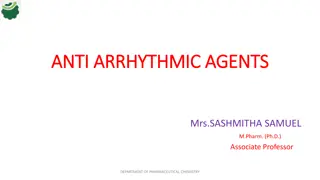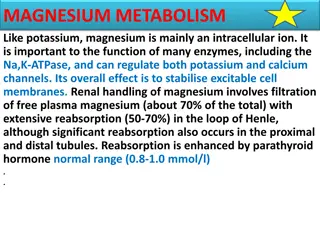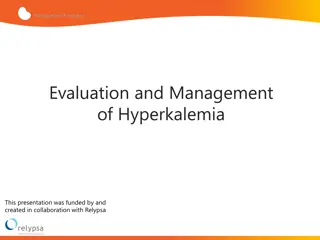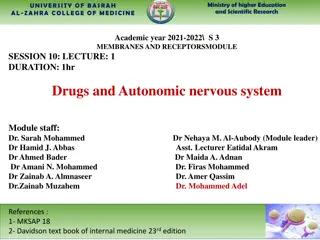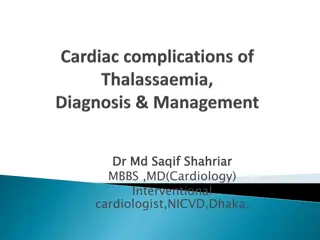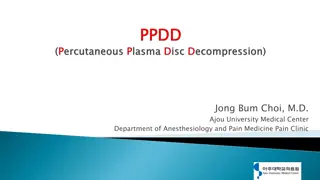Advanced Cardiovascular Life Support Algorithm
This advanced cardiovascular life support algorithm provides step-by-step guidance in managing cardiac emergencies such as cardiac arrest, arrhythmias, and other life-threatening conditions. The algorithm includes a series of slides detailing important procedures and interventions to improve patient
5 views • 9 slides
Emergency Drugs and Their Mechanisms of Action
Learn about essential emergency drugs such as Adrenaline, Adenosine, Atropine, Furosemide, Calcium Gluconate, and Lidocaine. Understand their mechanisms of action, dosages, indications, and onset times to effectively manage cardiac arrest, anaphylaxis, arrhythmias, and other critical conditions.
3 views • 17 slides
Antiarrhythmics
Cardiac arrhythmias are a common cause of death in patients with heart conditions. These abnormalities in heart rhythm can be due to issues with impulse generation or conduction. Antiarrhythmic medications play a crucial role in managing these conditions by affecting the action potentials of cardiac
3 views • 14 slides
Understanding Anti-Arrhythmic Agents in Cardiac Care
Anti-arrhythmic agents are crucial in managing abnormal heart rhythms like atrial fibrillation and ventricular tachycardia. Causes of arrhythmias vary from heart anatomy changes to medication side effects. Factors like exertion, imbalances in blood chemistry, and medication use can trigger arrhythmi
0 views • 39 slides
Clinical ECG Interpretation Elective: Learning Objectives and Activities
This rotation aims to enhance clinical skills in ECG interpretation with a focus on myocardial and conduction abnormalities, arrhythmias, and tachycardias. Students will engage in e-learning modules, case studies, and literature reviews to master ECG analysis. The course emphasizes patient care, med
0 views • 10 slides
Understanding Magnesium Metabolism and Hypomagnesaemia
Magnesium, mainly an intracellular ion, plays a crucial role in enzyme function and cell membrane stability. Its renal handling involves filtration and reabsorption, with hypomagnesaemia often linked to hypocalcaemia. Causes include inadequate intake, excessive losses from GI and urinary sources, an
0 views • 17 slides
Understanding Hyperkalemia: Causes, Evaluation, and Management
Hyperkalemia is a condition characterized by elevated serum potassium levels, posing serious risks such as cardiac arrhythmias and sudden death. Pathogenesis involves factors like abnormal potassium release, impaired distribution, and excretory process impairment. Causes range from pseudohyperkalemi
0 views • 35 slides
Clinical Cases and Image Findings in Cardiology and Neurology
Explore a collection of clinical cases and image findings covering topics such as widened mediastinum, tracheal deviation, subdural hematoma, myocardial infarction, and arrhythmias. Learn about different diagnostic modalities, operative treatments, and potential complications associated with these c
0 views • 17 slides
Understanding Autonomic Nervous System and Clinical Applications in Medicine
This academic session covers the effect of autonomic nervous system stimulation on various systems, clinical diseases, pathophysiological changes, disease management guidelines, and clinical applications of autonomic drugs. Common clinical applications of autonomic receptors agonists and antagonists
0 views • 23 slides
Understanding Cardiovascular Complications of Thalassaemia
Cardiovascular complications of thalassaemia can be categorized into iron overload-related issues such as myocyte failure and arrhythmias, and non-iron overload complications including pulmonary hypertension and atrial fibrillation. Cardiac iron accumulation poses a significant risk, leading to card
0 views • 36 slides
Ablation Techniques in Medical Practice
Ablation procedures like PPDD and Coagulation are effective methods for treating various conditions such as cardiac arrhythmias, tumors, and wound debridement. RF ablation offers advantages such as precise targeting, lower tissue temperatures, and tissue preservation at the molecular level. Understa
0 views • 33 slides



